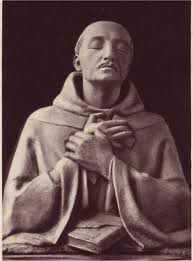Christian prayer is meant to blaze forth from the Deepest Center of the soul. In his powerful Living Flame of Love, St.  John of the Cross explains this Deepest Center. Many spiritual writers recognize the need for interiority that a term like the Deepest Center suggests. Sometimes, however, what certain authors describe as the center of the soul is difficult to distinguish from one’s own big fat ego. Contrary to some self-absorbed esoteric exercise, Christian prayer properly expresses itself in self-donation, a gift of self burning with love in humble response to an even greater love that has been lavished upon it.
John of the Cross explains this Deepest Center. Many spiritual writers recognize the need for interiority that a term like the Deepest Center suggests. Sometimes, however, what certain authors describe as the center of the soul is difficult to distinguish from one’s own big fat ego. Contrary to some self-absorbed esoteric exercise, Christian prayer properly expresses itself in self-donation, a gift of self burning with love in humble response to an even greater love that has been lavished upon it.
Because of a proclivity to turn in on ourselves, misunderstanding the reality John of the Cross calls the Deepest Center can contribute to a perilous pitfall in prayer. Our lack of love for God inclines us to self-preoccupation. It is quite possible to squander the precious little time we have for prayer wallowing in self-pity or delighting in some form of psychic relief or amusing ourselves with the achievement of various mental gymnastics. Such counterfeit prayer, however gratifying it might be for a time, never allows us to escape the gravity of sin. Instead of realizing its true purpose, the soul becomes an atomized monad of self-concern. Locked into our own fantasy, resentment, or worry, the wrong kind of introspection becomes a foretaste of hell.
The Deepest Center of the soul is not a psychological power even if this Hidden Mystery constantly influences all these faculties. The Deepest Center is nothing modern psychology can even properly identify. Though it pertains to the very substance of the soul, this unfathomable reality is not reducible to conscious or subconscious mental activity. On the other hand, without being aware of it, the soul can be moved in incomprehensible ways by this hidden Depth. No unaided psychological power can access this Deep Secret, and yet everything that “is” is rooted in it. This profound Mystery is not directly observable by any science although all true theology seeks its wonder. Life overflows with all kinds of the sanctifying effects that constantly indicate this ineffable Cause.
To understand this Deepest Center, St. John of the Cross points out that the soul is a simple, spiritual reality characterized by being, power, force of operation and movement. The animating principle of human life is not some spatial complex containing a fixed point or any other geometry within it. As it is a spiritual reality, it is too simple to be thought of as a thing with interior and exterior parts. It is simply one whole reality: a life principle in motion. This movement is not material or even from the material to the spiritual. This spiritual motion is not principally through space and time – even if each moment of our brief lives is given for this purpose. Instead, this movement is into a deeper unity with the One whom summons the soul and holds it in existence. Grace moves the soul to an ever deeper communion with God. It is meant for perfect unity with the Trinity.
The Deepest Center indicates the spiritual resting place to which the soul is drawn by love. This abyss does not absorb or destroy the soul, but the closer the soul draws to it, the more it becomes like it — and in this likeness the more this particular divine image realizes the purpose for which it exists. We exist for God’s love and to share this love with one another. This is what it means to be fully alive and to live to the full is to become the glory of God. It is in this bosom of the Trinity, the resting place of eternal love, that the soul is meant to dwell. The Trinity is the principle source of the spiritual life: the ultimate source and end of the soul’s being, life, purpose and prayer.
The soul drawn by God’s love gives itself, offers itself, abandons itself to God. It lives no longer alienated but in relation to God and to all that God loves. St. John of the Cross sees the soul as a reality only completely true to itself when imbued with grace, whose grace filled existence is cherished by God like a bride by her bridegroom.
To maintain the soul as the unique and unrepeatable object of God’s love, the Carmelite Doctor carefully distinguishes between God and the soul. Although he is sometimes misunderstood on this point, his thought avoids any sort of nihilism in which the substance of the soul is so absorbed in Divine Being that it ceases to exist altogether. He stresses the likeness between friends as that which draws them together but he never suggests that either the human “I” or Divine “Thou” ever cease to exist: distinction is what makes likeness so exquisite. His is a mysticism of divine friendship and, if he celebrates the transforming union of the soul in God, he is carefully attentive to the orders of nature and grace.
St. John of the Cross describes the soul as taking on a greater and greater likeness to God in the life of grace so that, though it is only a creature, it might enjoy an ever more tender friendship with its Creator. It is true that for this likeness and union to be realized, the soul must live no longer for itself. It must die to those natural impulses that drive it so that it might be free to live supernaturally for God. Such is the touch of the Holy Trinity: through the Gift of the Holy Spirit men and women super-abundantly receive the inexhaustible riches of Christ, the unfathomable love shared by the Father and the Son before the foundation of the world, a love given through the Cross.
The most powerful kind of prayer is sparked when the soul is touched by this wondrous glory which draws it deeper and deeper into love. What such prayer attains is of immeasurable good, not just for the soul itself, but for the whole world. This is where the dimensions of Christ’s love extend and this prayer wants to stretch to the same extent. The fire of this prayer blazes forth to coincide more and more with the ineffable desire of God who is the Furnace of all true Love. How can the Lord do anything other than answer the cries of a friend who shares so much with Him? Although the great saints know this in secret ways too beautiful to ever adequately describe, even a little love of God is enough for this tender dynamic to begin to be realized. If the smallest amount of such devotion can render the whole world so vulnerable to Divine Mercy, St. John of the Cross helps us see that it is only because the Trinity is even more vulnerable as the soul’s Deepest Center.
Note from Dan: Anthony’s fantastic book on prayer, Hidden Mountain Secret Garden, can be found HERE in print, and HERE in Kindle format.





